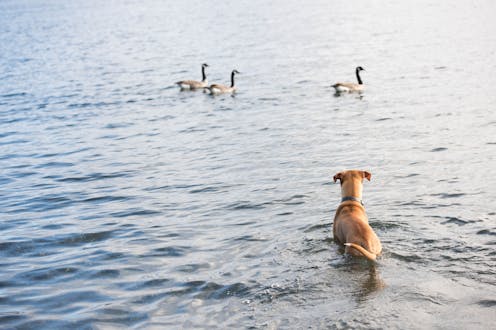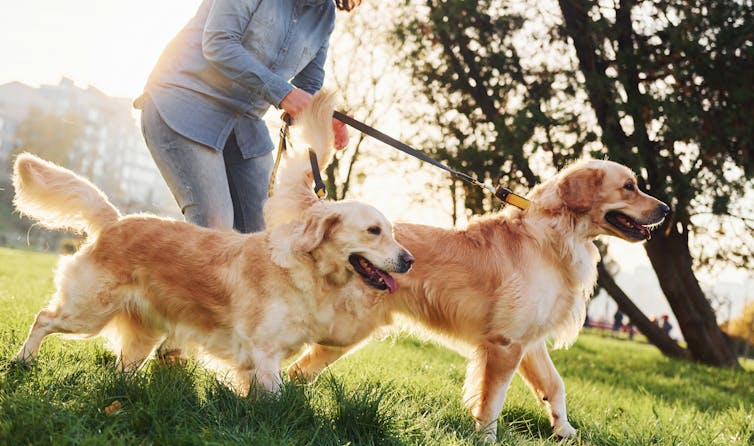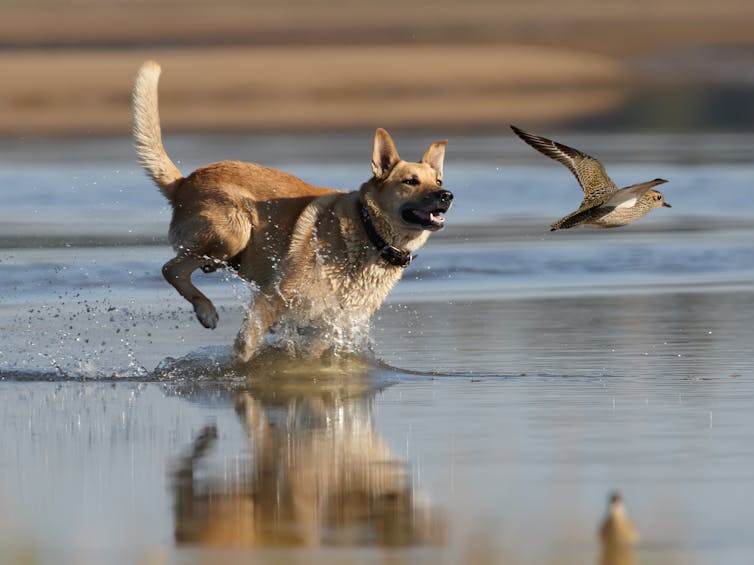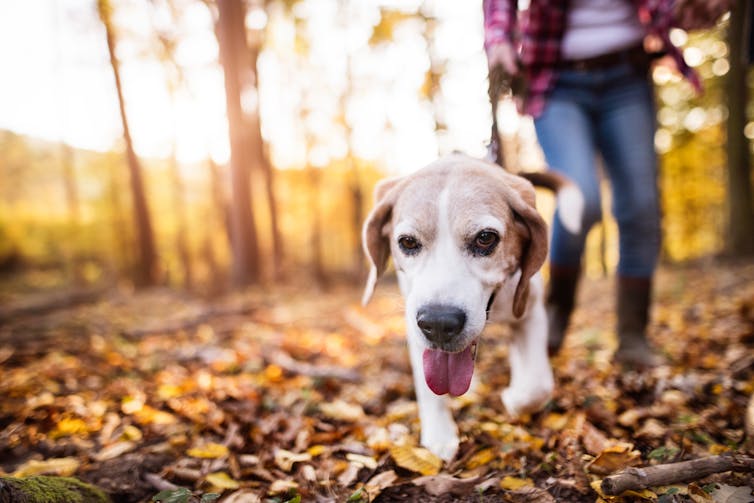
In Australia, dog ownership often goes hand-in-hand with a love for the great outdoors. Whether it’s walking on the beach, going camping, or having a barbecue in the park, we tend to keep our canine companions close as we soak up the sun.
But many of us forget a key fact about our dogs: they are predators. Even the fluffy little 5kg ball that spends most of its time in your lap derives from an apex predator – and its predatory instincts can kick in at any time.
And while many of our dogs don’t have the same hunting skills as their distant ancestors (who had to hunt for a living), wildlife doesn’t know that.
The impacts of domestic dogs on wildlife aren’t well studied, and likely vary depending on the environment. Nonetheless, there’s good evidence domestic dogs, when left unobserved, can have detrimental effects in the places they visit.
With that in mind, here are some things to consider next time you take your pup out for a bushwalk.
How dogs impact ecosystems
There are five main ways domestic dogs can negatively impact the natural environments they visit. These are:
- direct physical harm through predatory behaviour
- disturbance through chasing and harassment
- increased exposure to diseases
- interbreeding, which can alter the gene pool of wild canid populations
- increased competition for resources.
The good news is the last three points aren’t particularly relevant in Australia. For one thing, there’s little overlap between diseases common in domestic dogs and Australian wildlife. There’s also little resource overlap, except perhaps in some areas where feral or semi-feral dogs live alongside dingoes.
And regarding potential interbreeding, while it was once thought this could threaten the dingo gene pool, recent research suggests it’s not nearly as common as we thought.
As such, the main harms Aussie dog owners should focus on are physical harms through predatory behaviour and disturbance to ecosystems.

Dogs can kill
We know dogs are capable of injuring and killing wildlife, but it’s difficult to determine how common this is, because many events go unreported. While smaller animals such as lizards, gliders and possums are at higher risk, larger species such as koalas can also fall prey to dogs.
One study that looked at wildlife coming into care at Queensland rehabilitation centres reported dog attacks as the cause in about 9% of cases. These cases often resulted in severe injury or death.
Dog owners should be especially wary of small, localised populations of vulnerable species. A study in Argentina’s Patagonia region details several cases of dogs decimating local penguin populations after gaining access to protected island areas during low tide.
Not to mention, dog attacks on wildlife can bring risk to dogs as well. Kangaroos can defend themselves with their powerful limbs, monitor lizards are equipped with sharp claws and teeth, and many snake species are highly venomous.
Read more: Do dog 'talking buttons' actually work? Does my dog understand me? Here's what the science says
The impact of harassment
You might think it’s harmless for your dog to chase wildlife if it never manages to catch the animals it chases, but that isn’t true. Wild animals optimise their behaviours to meet their needs for foraging, breeding and resting, and being chased by a dog can disrupt this.
For example, certain threatened bird species will nest on the beach and find foraging opportunities based on the tides. One dog forcing one bird to abandon this important activity may have a small impact. But if it happens repeatedly throughout the day, it can become a much bigger problem. It may even drive animals out of the area.
Research conducted in Sydney has shown the mere presence of a leashed dog is enough to temporarily, yet dramatically, reduce the number of bird species detected.

Keep an eye on your furry pal
Responsible dog ownership involves making sure our dogs have a minimal impact on others, including wildlife. How can we achieve this when our dogs are simply engaging in behaviours that come naturally to them, and may even be rewarding for them?
Training your dog to have general obedience – especially to come when called – is worth sinking considerable time and effort into. This can save both your dog and any wildlife they may be after. For instance, calling a dog away from a snake is one of the most effective ways of managing snake bite risk.
One pilot study in Victoria found positive outcomes from a program that helped owners train their dogs to be more obedient around wildlife.
That said, recall training is an art form, and recalling a dog that likes to run off and chase animals can be a huge challenge.
Another solution is to rely on leashes when passing sensitive areas, or where there’s a risk of wildlife harassment. In Australia, many beaches that allow dogs have signs with information about vulnerable birds in the area and how to protect them from your dog.
This could mean keeping your dog off rock platforms, leashing them when you see birds foraging on the beach, or keeping them out of fenced areas. Some areas are simply too vulnerable for dogs to run amok, so always look for signs and read them carefully.
If you’re hiking, use a long line (a leash that’s more than five metres long) and look for signs of your dog detecting something of interest. Often their ears will come up high and forward, and they will freeze and stare intently.
At this point, it doesn’t matter what they’re excited about: take the opportunity to leash them or shorten their leash, and get their attention before they can take off. Investing in a long leash will allow your dog more freedom without putting wildlife at risk.

If your dog does injure an animal, you should quickly contact a wildlife rescue organisation or take the animal to a veterinary practice or sanctuary. For small animals, even minor injuries from a dog will usually require veterinary attention.
It’s our responsibility to be respectful visitors when we’re out in nature, and to make sure our dogs are too.
Read more: If humans disappeared, what would happen to our dogs?
Melissa Starling owns Creature Teacher, an animal behaviour and training consulting business.
This article was originally published on The Conversation. Read the original article.







